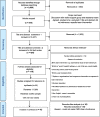Team interventions in acute hospital contexts: a systematic search of the literature using realist synthesis
- PMID: 29996820
- PMCID: PMC6042358
- DOI: 10.1186/s12913-018-3331-3
Team interventions in acute hospital contexts: a systematic search of the literature using realist synthesis
Abstract
Background: Research on team effectiveness in healthcare has focussed on whether effective teams yield positive outcomes for patients and on the effectiveness of team interventions to improve performance. Limited understanding exists of what works for whom within an effective team, or how and why the context in which the team operates enables team members both as individuals and as a collective to enact behaviours that promote positive outcomes.
Methods: This realist synthesis of the literature explores the relationship between team interventions, underlying teamwork mechanisms generated by those interventions, and the resultant impact on patient outcomes in an acute hospital context. A systematic search of five healthcare and healthcare management academic databases: PubMed, PsychINFO, CINAHL, ABInform, Emerald Management and three grey literature databases: ERIC, OpenDOAR and Open Grey was undertaken. Five experts in the field were also contacted to source relevant literature. Using PRISMA guidelines, relevant studies published between January 2006 and January 2017 were systematically searched by a team of three people. Drawing on realist methodology, data were synthesised using context, mechanism and outcome configurations as the unit of analysis to identify enablers and barriers to effective team interventions.
Results: Out of 3347 papers retrieved, 18 were included in the final synthesis. From these, five contextual enablers were identified: an inter-disciplinary focus and flattened hierarchy; effective communication; leadership support and alignment of team goals with organisational goals; credibility of intervention; and appropriate team composition with physician involvement. Ten recurring mechanisms were identified, the most frequently occurring of which was shared responsibility.
Conclusions: The advantage of using realist synthesis to extrapolate data from the literature is that it considers the context and mechanisms that will impact effectiveness of healthcare team interventions. This methodological approach provides a different perspective to other types of syntheses and offers insight as to why certain contextual elements may yield more success than others. Findings therefore tend to have more practical implications. Specificity of detail in terms of how external drivers impact on healthcare team interventions was limited in the articles extracted for analysis. This broader perspective is therefore an important consideration for future research.
Keywords: Acute hospital; Context; Effectiveness; Interdisciplinary; Interventions; Quality; Realist; Safety; Synthesis; Team.
Conflict of interest statement
Authors’ information
Una Cunningham, Mater Misericordiae University Hospital Dublin, ucunningham@mater.ie.
Ethics approval and consent to participate
Not applicable.
Consent for publication
Not applicable
Competing interests
The authors declare that they have no competing interests.
Publisher’s Note
Springer Nature remains neutral with regard to jurisdictional claims in published maps and institutional affiliations.
Similar articles
-
The Effectiveness of Integrated Care Pathways for Adults and Children in Health Care Settings: A Systematic Review.JBI Libr Syst Rev. 2009;7(3):80-129. doi: 10.11124/01938924-200907030-00001. JBI Libr Syst Rev. 2009. PMID: 27820426
-
Beyond the black stump: rapid reviews of health research issues affecting regional, rural and remote Australia.Med J Aust. 2020 Dec;213 Suppl 11:S3-S32.e1. doi: 10.5694/mja2.50881. Med J Aust. 2020. PMID: 33314144
-
How has the impact of 'care pathway technologies' on service integration in stroke care been measured and what is the strength of the evidence to support their effectiveness in this respect?Int J Evid Based Healthc. 2008 Mar;6(1):78-110. doi: 10.1111/j.1744-1609.2007.00098.x. Int J Evid Based Healthc. 2008. PMID: 21631815
-
How and under what circumstances do quality improvement collaboratives lead to better outcomes? A systematic review.Implement Sci. 2020 May 4;15(1):27. doi: 10.1186/s13012-020-0978-z. Implement Sci. 2020. PMID: 32366269 Free PMC article.
-
Towards achieving interorganisational collaboration between health-care providers: a realist evidence synthesis.Health Soc Care Deliv Res. 2023 Jun;11(6):1-130. doi: 10.3310/KPLT1423. Health Soc Care Deliv Res. 2023. PMID: 37469292
Cited by
-
Collaboration between parents and SLTs produces optimal outcomes for children attending speech and language therapy: Gathering the evidence.Int J Lang Commun Disord. 2020 Jul;55(4):618-628. doi: 10.1111/1460-6984.12538. Epub 2020 May 8. Int J Lang Commun Disord. 2020. PMID: 32383829 Free PMC article.
-
Application of the critical incident technique in refining a realist initial programme theory.BMC Med Res Methodol. 2020 May 26;20(1):131. doi: 10.1186/s12874-020-01016-9. BMC Med Res Methodol. 2020. PMID: 32456682 Free PMC article.
-
Longitudinal team training programme in a Norwegian surgical ward: a qualitative study of nurses' and physicians' experiences with teamwork skills.BMJ Open. 2020 Jul 8;10(7):e035432. doi: 10.1136/bmjopen-2019-035432. BMJ Open. 2020. PMID: 32641327 Free PMC article.
-
Longitudinal team training program in a Norwegian surgical ward: a qualitative study of nurses' and physicians' experiences with implementation.BMC Health Serv Res. 2021 Jul 23;21(1):725. doi: 10.1186/s12913-021-06732-6. BMC Health Serv Res. 2021. PMID: 34294085 Free PMC article.
-
Green Cross method in a postanaesthesia care unit: a qualitative study of the healthcare professionals' experiences after 3 years, including the COVID-19 pandemic period.BMJ Open Qual. 2023 May;12(2):e002247. doi: 10.1136/bmjoq-2022-002247. BMJ Open Qual. 2023. PMID: 37225257 Free PMC article.
References
-
- Emanuel L, Berwick D, Conway J, et al. Advances in Patient Safety. What Exactly Is Patient Safety? In: Henriksen K, Battles JB, Keyes MA, Grady ML, editors. Advances in Patient Safety: New Directions and Alternative Approaches. Vol. 1. Rockville (MD): Agency for Healthcare Research and Quality; 2008. Assessment. Available from: https://www.ncbi.nlm.nih.gov/books/NBK43629/. - PubMed
-
- Schmutz J, Hoffmann F, Heimberg E, Manser T. Effective coordination in medical emergency teams: the moderating role of task type. Eur J Work Organ Psy. 2015;24:761–776. doi: 10.1080/1359432X.2015.1018184. - DOI
Publication types
MeSH terms
LinkOut - more resources
Full Text Sources
Other Literature Sources


